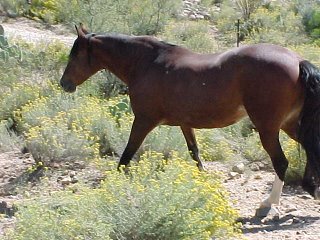I lost my first Peruvian mare, Perla de Oro, because of poor nutrition. What I didn't know at the time was that she most likely was insulin resistant (IR).
Perla was pregnant with twins (the last sonogram showed only one) which she lost at eight months; one was mummified and likely had been dead for a while. The placenta was retained and, despite the best efforts of my veterinarian, she foundered.
Perla had the "typical" signs of IR — overweight with patchy fat, cresty neck, dropped topline, hungry and thirsty all the time. The usual way of dealing with the overweight horse at that time was to restrict intake — so she was put on two light flakes of Bermuda hay with a little senior feed to provide some minerals and vitamins.
While her founder improved (with the help of a natural trimmer and custom Horse Sneakers), she did not lose her fat or cresty neck. But her immune system became severely depleted and was overwhelmed by a salmonella infection. Though she tried to fight it up to the last minute, Perla died a terrible painful death. Since that day I have been plagued with "what ifs" and guilt.
When my Peruvian filly, La Perricholi, began to show a cresty neck and excess fat on a conservative diet of Bermuda hay and small amounts of Strategy, I started to explore the web. When Perla foundered in 1996, I had found Gretchen Fatenhauer's website which has since evolved and expanded. Gretchen was one of the pioneers of the "barefoot horse movement" and became a supporter of Hildebrand Strasser. While many consider Dr. Strasser's techniques controversial, all barefoot horses and their owners owe her and Gretchen a debt in reintroducing us to a more natural lifestyle for our horses.
From there, I came across the Equine Cushings group on Yahoo — created by Robin Siskel and moderated by Eleanor Kellon, VMD. When I joined the group in September 2000, there were some 300 plus members, by November of 2003, there were over 1,000 group members — there are now over 4,000! It was here I learned about hay analysis, mineral balancing, the NRC (National Research Council Nutrient Requirements of Horses), low NSC hay (Non-Structural Carbohydrates or sugar/starch) and how they all come together to affect our horses.
As I began to understand what horses need nutritionally, I developed spread sheets to calculate all the math, shared them with other list members, and tried to help those who were "math challenged". Since then, most of my free time has been devoted to studying and learning about equine nutrition — expanding from the IR and Cushing's horse to helping horse owners in the Southwest develop better rations for their foals and performance horses.
At my trimmer's request, I made a regional supplement I had formulated for my own horses available to her clients and have had the satisfaction of seeing many horses develop the good feet, shiny coat and improved attitude that reflects good health.
This has evolved into Desert Equine Balance — which I hesitate to call a "business" as I haven't really figured out how to make money at it. While I do charge for consults, the greatest satisfaction is in seeing healthy foals, horses becoming fit and athletic and laminitic horses getting a new lease on life — along with their owners gaining a new understanding of equine nutrition.
My path to learning and what I may accomplish for these horses is thanks to the generous sharing of her knowledge and experience by Eleanor Kellon, VMD.
Email Patti at Desert Equine Balance


No comments:
Post a Comment